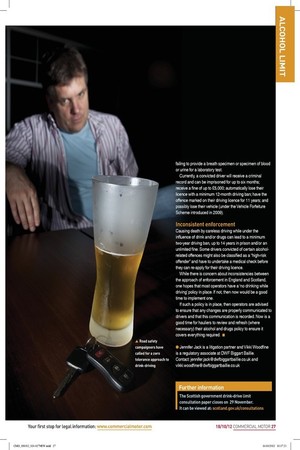Know your limits
Page 19

Page 20

If you've noticed an error in this article please click here to report it so we can fix it.
As the Scottish government considers introducing tougher drink-drive limits, hauliers need to refresh their knowledge of the law and review alcohol policies, advises transport law firm DWF Biggart Baillie
Words: Jennifer Jack and Vikki Woodfine The blood alcohol limit for driving in the UK has remained unchanged since 1966. The legal limit is 80mg of alcohol per 100ml of blood (35mg of alcohol per 100ml of breath) higher than in most other European countries.
Last month the Scottish government launched a consultation over proposals to lower the limit in Scotland to 50mg of alcohol per 100ml of blood to bring it in line with much of the Continent. Cyprus, France, the Netherlands, Germany, Luxembourg and Ireland have all reduced drink-driving limits in line with a European Commission recommendation made in 2001.
The Scottish government’s move also reflects an independent review of drink and drug driving law commissioned in 2009 by the then UK government. Conducted by the North Review Committee, led by Sir Peter North CBE QC, the report indicated that a lower drink limit of 50mg of alcohol in 100ml of blood would help save lives.
The North Report estimated that introducing a lower limit could result in about 43 lives being saved in Britain each year. Other research has shown more ambitious estimates. The Albalate study of European countries estimates 77 to 168 lives could be saved each year in England and Wales, while Australian research suggests it could be 144 lives saved after the first year, progressively increasing until by the sixth year, up to 303 deaths are avoided.
These estimates for England and Wales take no account of the possible casualty savings for Scotland. It should be noted that Scotland represented 7% of all drink-drive related casualties in Britain in 2008.
Applying these figures to the proposed lower Scottish drink-driving limit suggests the lower limits would result in between three and 17 fewer deaths a year. The North Report also indicated that evidence showed that drivers with a blood alcohol concentration level between 50mg and 80mg per 100ml of blood are six times more likely to die than those with zero blood alcohol.
The British Medical Association has lent its support to calls for a reduction in the prescribed limits, making reference to evidence indicating that the risk of being involved in a road traffic accident is 10 times higher for drivers with a reading of 80mg of alcohol per 100ml of blood than those with a zero blood alcohol reading; the relative crash risk for drivers with a reading of 50mg of alcohol per 100ml of blood was double that of drivers with a zero blood alcohol reading.
Zero tolerance
Many road safety campaigners have welcomed the Scottish government’s proposals, although some say they do not go far enough and have called for a zero tolerance approach. Others have, however, raised concerns that the proposals would create confusion among drivers, particularly with the limits in Scotland differing from those throughout the rest of the UK.
While the power to legislate on blood alcohol limits has been devolved to the Scottish Parliament, the penalties that may be applied for driving while above the prescribed limit remain with Westminster.
Courts have a range of sanctions for dealing with someone convicted of driving or attempting to drive while over the legal limit, whether for alcohol or drugs, or for failing to provide a breath specimen or specimen of blood or urine for a laboratory test.
Currently, a convicted driver will receive a criminal record and can be imprisoned for up to six months; receive a fine of up to £5,000; automatically lose their licence with a minimum 12-month driving ban; have the offence marked on their driving licence for 11 years; and possibly lose their vehicle (under the Vehicle Forfeiture Scheme introduced in 2009).
Inconsistent enforcement
Causing death by careless driving while under the influence of drink and/or drugs can lead to a minimum two-year driving ban, up to 14 years in prison and/or an unlimited fine. Some drivers convicted of certain alcoholrelated offences might also be classified as a “high-risk offender” and have to undertake a medical check before they can re-apply for their driving licence.
While there is concern about inconsistencies between the approach of enforcement in England and Scotland, one hopes that most operators have a ‘no drinking while driving’ policy in place. If not, then now would be a good time to implement one.
If such a policy is in place, then operators are advised to ensure that any changes are properly communicated to drivers and that this communication is recorded. Now is a good time for hauliers to review and refresh (where necessary) their alcohol and drugs policy to ensure it covers everything required. n l Jennifer Jack is a litigation partner and Vikki Woodfine is a regulatory associate at DWF Biggart Baillie. Contact: jennifer.jack@dwfbiggartbaillie.co.uk and vikki.woodfine@dwfbiggartbaillie.co.uk











































